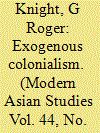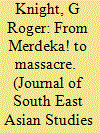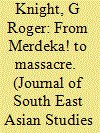|
|
|
Sort Order |
|
|
|
Items / Page
|
|
|
|
|
|
|
| Srl | Item |
| 1 |
ID:
095238


|
|
|
|
|
| Publication |
2010.
|
| Summary/Abstract |
This paper discusses the commercial history of the Java sugar industry in the interwar decades of the 1920s and 1930s. Java's late colonial industry had a uniquely exogenous character, in that, amongst the world's major producers of cane sugar in the late colonial era, it was singularly devoid of metropolitan or quasi-metropolitan markets. Instead, it sought its markets pre-eminently on the Asian 'mainland' to its north and northwest. The Indian subcontinent formed one such market, but East Asia formed the second, and it is the Java industry's fortunes in China and Japan that provide the focus of the present paper. This focus highlights the extent to which the partial collapse of the industry in the mid-1930s related to factors altogether more complex than a simple fall in consumption and drop in prices associated with the interwar Depression. Fundamentally, it was evolving economic autarchy throughout east Asia, encouraged by Depression conditions, which lay at the heart of the Java sugar industry's problems in this sector of its market. Key factors were Java's ambivalent relationship with an expanding but crisis-ridden Japanese sugar 'empire,' and the effect on its long-standing links with British sugar refineries in Hong Kong because of the latter's increasing difficulties in the China market. In tandem, they underscored the commercial hazards inherent in Java sugar's exogenous situation.
|
|
|
|
|
|
|
|
|
|
|
|
|
|
|
|
| 2 |
ID:
117475


|
|
|
|
|
| Publication |
2012.
|
| Summary/Abstract |
Between 1945 and 1965, what may be broadly defined as the politics of sugar in Indonesia passed through several critical stages. The industrial manufacture of sugar had begun in the Netherlands Indies in the mid-nineteenth century, but after a slump during the 1930s Depression, the industry virtually went into abeyance during the Japanese Occupation (1942-45). After the war, the years of struggle for Merdeka! (freedom) also saw a partial revival of the industry, which continued through national revolution and independence (1949) through to an incremental nationalisation in the late 1950s. Developments in the sugar industry culminated in massacre, rather than merdeka, however. The campaign against the PKI (Indonesian Communist Party) which began in 1965 resulted in the murder of labour unionists and peasant activists associated with the sugar industry. This paper traces the course of events from Merdeka to massacre, focusing on the sugar industry of East Java's Brantas valley. Its themes, however, relate to the industry in Java as a whole, and the question of why the commodity production of sugar came to be so deeply embroiled in the politics of the new republic.
|
|
|
|
|
|
|
|
|
|
|
|
|
|
|
|
| 3 |
ID:
117476


|
|
|
|
|
| Publication |
2012.
|
| Summary/Abstract |
Between 1945 and 1965, what may be broadly defined as the politics of sugar in Indonesia passed through several critical stages. The industrial manufacture of sugar had begun in the Netherlands Indies in the mid-nineteenth century, but after a slump during the 1930s Depression, the industry virtually went into abeyance during the Japanese Occupation (1942-45). After the war, the years of struggle for Merdeka! (freedom) also saw a partial revival of the industry, which continued through national revolution and independence (1949) through to an incremental nationalisation in the late 1950s. Developments in the sugar industry culminated in massacre, rather than merdeka, however. The campaign against the PKI (Indonesian Communist Party) which began in 1965 resulted in the murder of labour unionists and peasant activists associated with the sugar industry. This paper traces the course of events from Merdeka to massacre, focusing on the sugar industry of East Java's Brantas valley. Its themes, however, relate to the industry in Java as a whole, and the question of why the commodity production of sugar came to be so deeply embroiled in the politics of the new republic.
|
|
|
|
|
|
|
|
|
|
|
|
|
|
|
|
|
|
|
|
|